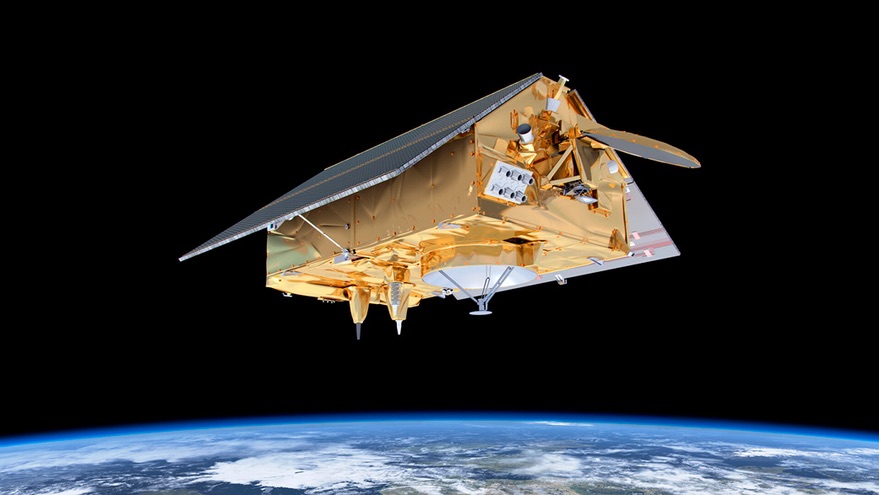WASHINGTON — A SpaceX Falcon 9 successfully launched Nov. 21 the latest in a series of satellites developed by the United States and Europe to track rising sea levels.
The Falcon 9 lifted off from Space Launch Complex (SLC) 4 East at Vandenberg Air Force Base in California at 12:17 p.m. Eastern. Its payload, the Sentinel-6 Michael Freilich satellite, separated from the rocket’s upper stage nearly an hour later, after a brief second burn of the upper stage. The rocket’s first stage landed on a pad back at SLC-4.
Sentinel-6 Michael Freilich is the first of two satellites jointly developed by a group of agencies in the United States and Europe, including NASA, NOAA, the European Space Agency, Eumetsat and the European Commission, to provide precise measurements of rising sea levels.
The spacecraft will ensure a continuity of measurements dating back nearly three decades, starting with the TOPEX/Poseidon satellite launched in 1992 and followed by the three Jason spacecraft launched in 2001, 2008 and 2016. Those earlier spacecraft were joint projects of NASA, NOAA, Eumetsat and the French space agency CNES, while Sentinel-6 Michael Freilich is considered part of the Copernicus program of Earth observation satellites by ESA and the EU.
“It’s the first time that ESA and NASA have really collaborated in such an integrated way on an Earth observation satellite,” said Pierrik Vuilleumier, Sentinel-6 project manager at ESA, during a Nov. 20 pre-launch briefing. NASA and ESA are each spending about half a billion dollars on the total program, which includes a second Sentinel-6 satellite that will launch in the middle of the decade.
The spacecraft itself, weighing 1,192 kilograms at launch, was built by Airbus Defence and Space in Germany. It has a distinctive appearance with two body-mounted solar panels that look like the roof of a house. That design is intended to maximize the power they can provide without requiring the use of deployable arrays and motors than can induce vibrations in the spacecraft.
The spacecraft’s main instrument is a radar altimeter provided by ESA, which bounces radio pulses off the ocean to measure sea level as well as wave height and ocean speed. It is supported by a microwave radiometer developed at NASA’s Jet Propulsion Laboratory, which measures water vapor in the atmosphere to providing timing corrections for the radar altimeter.
Also on Sentinel-6 Michael Freilich is a global navigation satellite system radio occultation (GNSS-RO) instrument to provide measurements of the atmospheric temperature and moisture by measuring signals from GPS and other navigation satellites. That instrument is similar to those on the six COSMIC-2 satellites launched in June 2019. In addition to measuring atmospheric conditions, data from the GNSS-RO instrument will be used with that from three other sensors to precisely measure the spacecraft’s orbit, at an altitude of 1,336 kilometers and an inclination of 66 degrees.
Sentinel-6 Michael Freilich will operate in the same orbit as Jason-3, with the two satellites about 30 seconds apart. That will assist in the commissioning of the new spacecraft, a process that will take about a year, said Remko Scharroo, project scientist for the mission at Eumetsat. “They will basically see the same ocean conditions, and that, of course, makes comparing the measurements much better,” he said at a pre-launch briefing.
While the spacecraft features improved resolution and precision compared to its predecessors, scientists emphasized the importance of continuing a series of measurements of sea level height dating back nearly three decades. Sentinel-6 Michael Freilich “will continue our record of sea surface height observations well into the next decade,” said Karen St. Germain, director of NASA’s Earth science division.
“It’s a critical observation for a number of reasons, but its power is really unleashed when we combine our altimetry observations of the sea surface height measurements with the observations we get from the other satellites in the NASA fleet and the international fleet,” she continued. “We can see not only that the sea level is rising but we can also tell how much of that change is coming from melting ice sheets and glaciers, and how much of that change is coming from thermal expansion of the oceans themselves.”
That satellite data has shown that sea levels are not only rising, but also that the rate of increase is accelerating. Sea levels were rising at the rate of about two millimeters per year in the 1990s, said Josh Willis, project scientist for the mission at JPL, but are now increasing at four to five millimeters per year. “We’re watching the rate of sea-level rise increase right before our very eyes, and it’s satellites like this that allow us to do it,” he said.
“We cannot ignore that our planet is changing,” said Pierre Delsaux, deputy director general for space for the European Commission, at a briefing about the mission in October. “The climate is changing. Nobody can deny it. From that point of view, we need to understand why the climate is changing, what are the factors, and we need to monitor the situation.”
NASA and ESA named the spacecraft after Michael Freilich, a former director of NASA’s Earth science division, during a ceremony early this year. Freilich, who retired from NASA in 2019 after leading NASA’s Earth science programs for more than a decade, died of cancer in August.
“This partnership is very much aligned with what Mike Freilich’s passion has been,” said Thomas Zurbuchen, NASA associate administrator for science, at the pre-launch briefing, noting Freilich’s research in ocean sciences before taking the NASA position. “I want to tell you how honored I feel, and how it still moves me today, that the name of Michael Freilich is, in fact, on this spacecraft.”
“It’s an extra special day when we will see this satellite launch, the satellite that he worked so hard to put in place,” said St. Germain.
